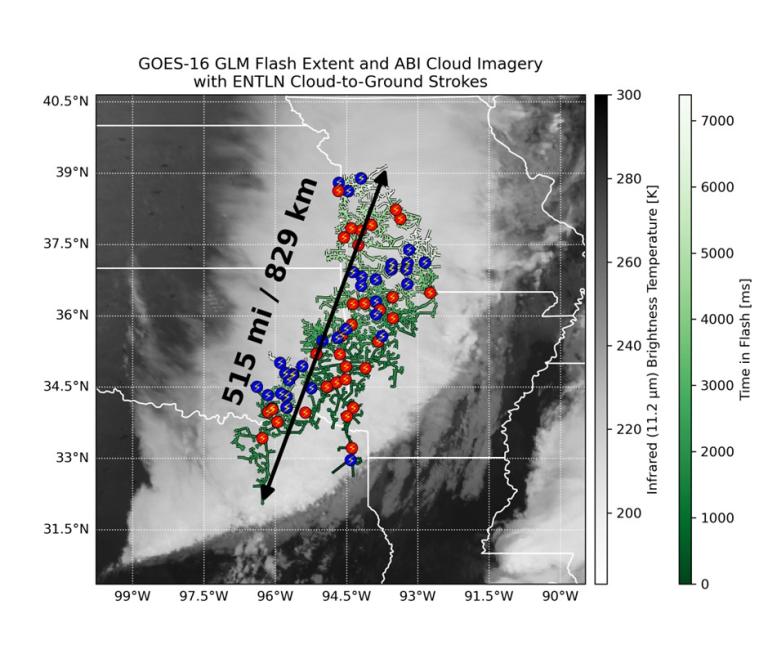There is a new world record for the longest single lightning strike. The World Meteorological Organization (WMO) has confirmed a bolt that crossed the southern states of North America, from eastern Texas to near Kansas City in Missouri, in October 2017, stretched for an incredible 829 kilometers (515 miles), beating the previous record holder by 61 kilometers (38 miles).
This incredible megaflash occurred in one of the most famous hot spots for Mesoscale Convective System (MCS) thunderstorms, the Great Plains of North America. MCS thunderstorms have the right conditions to create these incredible lightning strikes that travel across hundreds of kilometers of clouds in seconds. The previous longest megaflash, at 768 kilometers (477.2 miles), was also over the Great Plains, stretching across parts of Texas and Mississippi on April 29, 2020.
If you are wondering how an older bolt has only broken the record now, it’s because no one realized it in 2017. Thanks to archival data reexamination, it got spotted. The 2017 storm was notable because it was the first of which NOAA’s newest (at the time) Geostationary Operational Environmental Satellite (GOES-16) documented lightning megaflashes. But the researchers missed this event in the data. Looking back at it with many years of insights into extreme lightning events got them to say “hey, wait a minute!”
“This new record clearly demonstrates the incredible power of the natural environment,” Professor Randall Cerveny, rapporteur of the WMO’s Committee on Weather and Climate Extremes, said in a statement. “Additionally, WMO assessment of environmental extremes such as this lightning distance record testify to the significant scientific progress in observing, documenting, and evaluating such events. It is likely that even greater extremes still exist, and that we will be able to observe them as additional high-quality lightning measurements accumulate over time.”

Satellite image showing the record-breaking strike stretching from eastern Texas to near Kansas City, MO, during a storm on October 22, 2017.
Image credit: WMO
Fascinating as it is, the fact that lightning can travel so far is of major concern for public safety in many aspects, including aviation. The WMO stresses how dangerous lightning can be. The largest number of direct casualties was a strike that killed 21 people in Zimbabwe in 1975. The highest indirect number is 469 people in Dronka, Egypt, following lightning striking a set of oil tanks, leading to burning oil flooding the town.
“Investigation of megaflashes is providing new insights into the mesoscale electrical charge variations in Mesoscale Convective System thunderstorms. Furthermore, it illustrates the threat of the newly recognized “bolt from the gray,” analogous to the “bolt from the blue” from isolated cells, but one that can travel many hundreds of kilometers from the main charge-generating region,” said lightning specialist and committee member Walt Lyons.
“The only lightning-safe locations are substantial buildings that have wiring and plumbing; not structures such as at a beach or bus stop. The second reliably safe location is inside a fully enclosed metal-topped vehicle; not dune buggies or motorcycles,” he added..
“If lightning is within 10 km, as found with reliable lightning data, go to the lightning-safe building or vehicle. As these extreme cases show, lightning can arrive within seconds over a long distance, but they are embedded within larger thunderstorms, so be aware.”
The findings show how crucial space observations are to studying extreme phenomena. Without them, we would not have discovered the megaflashes.
Although many of the world’s record-breaking lightning strikes have occurred over the Great Plains in the US, it is not considered the “lightning capital of the world”. Venezuela claims that spot with electrical storms that can see 280 flashes per hour.
Source Link: Megaflash Stretching 892 Kilometers Sets New World Record For Longest Lightning Strike